| Crash site |
Nairobi/Embakasi Airport, Kenya |
| Airline |
Deutsche Lufthansa |
| Aircraft |
Boeing 747-130 – D-ABYB – Hessen |
| Route |
Frankfurt – Nairobi – Johannesburg |
| Crew |
17 – 13 survivors |
| Passengers |
140 – 85 survivors |
The crash
Shortly after take off from Nairobi the crew felt vibrations. The captain, suspecting wheel imbalance, raised the gear. A lack of acceleration forced the crew to lower the nose in order to maintain airspeed. The Boeing continued to descend however and at 07:54 the plane hit the ground 1120 m past the end of runway 24 and struck an elevated road a little further on. The aircraft broke up and caught fire before coming to rest 454 m past the initial point of impact.
The accident was caused by the crew initiating a take-off with the leading edge flaps retracted because the pneumatic system which operates them had not been switched on. This resulted in the aircraft becoming airborne in a partially stalled condition which the pilots did not identify in the short time available to them for recovery. Another factor was the lack of a warning of a critical flap positions.
The mail
On board the plane was mail destined for South Africa and Botswana and sent from a wide range of countries in Asia, Europe and Africa.
A part of the mail was recovered. Contemporary newspapers talk of 10.000 letters being recovered – most of the mail came from Germany.
The South African Post applied a special handstamp on all the recovered items.
For unknown reasons a few items were returned to the senders via Germany. Two different handstamps were used – see below E + F.
As to Nordic mail I have recorded the following number of items:
| |
Denmark |
Finland |
Norway |
Sweden |
| To South Africa |
13 |
1 |
3 |
7 |
A.
Handstamp.
Bilingual – English/Afrikaans.
Red and shades of purple.
Size: 63 x 18 mm.
Probably more identical handstampe were produced, as they appear in a variety of colour shades.
As mentioned above a few items were returned to the senders via Germany. These items were handled at the “Luftpostleitstelle” at the Köln/Bonn airport.
Returned mail is rare and I have only seen one Swedish cover (see below) and a cover from Singapore.
E.
German handstamp.
Violet.
Size: 60 x 32 mm.
The text is rather strange.
“Aeroplane chute” sounds French (airplane falling) ?
But “Kenia” is German for Kenya.
F.
German handstamp.
Violet.
Size: 38 x 45 mm.
With small datestamp -4.12.74
Examples of mail
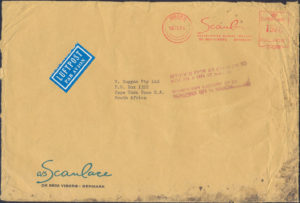 |
|
Cover from Denmark with metermark VIBORG 18.11.74 to Cape Town, South Africa. The cover was forwarded with the usual handstamp type A.
Thiesen Collection. |
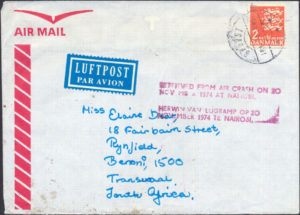 |
|
|
Cover from Denmark postmarked BROVST 18.11.74 to Transvaal, South Africa. The cover show very little damage and was forwarded with the usual crash handstamp.
Thiesen Collection.
|
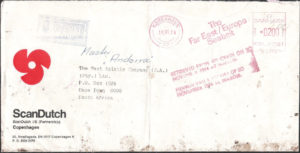 |
|
|
Cover from Copenhagen, Denmark with metermark KØBENHAVN 18.11.74 to Cape Town, South Africa. The cover was forwarded with the usual handstamp type A.
Thiesen Collection.
|
 |
|
|
Cover from Denmark with metermark BAGSVÆRD 18.11.74 to Johannesburg, South Africa. The cover which was badly torn was forwarded wit the usual crash handstamp type A.
|
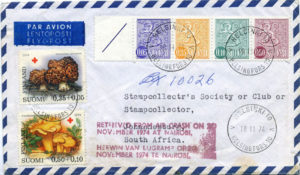 |
|
|
A philatelic cover from Finland postmarked HELSINKI/HELSINGFORS 18 11 74 and addressed to Stamp Society, Club or Collector in Johannesburg. The South African Post tried to find someone at P.O. Box 10026. The cover show the usual crash handstamp.
Ala-Honkola Collection.
|
 |
|
|
Cover from Norway postmarked BERGEN 18.11.74 to Durban, South Africa with crash handstamp type A.
Thiesen Collection.
|
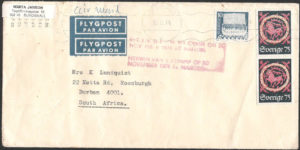 |
|
|
Cover from Sweden postmarked SUNDSVALL 18.11.74 to Durban, South Africa. Forwarded with crash handstamp type A.
Thiesen Collection.
|
 |
|
|
Cover from Sweden postmarked TRANÅS 18.11.1974 to Cape Town, South Africa with the usual crash handstamp.
|
|

|
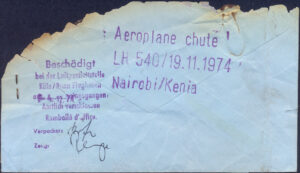
|
 |
|
|
This cover is quite a mystery. How can a cover sent from South Africa end up in this crash at Nairobi?
Well here is my attempt to explain what happened:
On 29.10.1974 the company Ingersoll-Rand, South Africa sent an airmail cover to Dynapac, Solna, Sweden (metermark CAPE TOWN 20 X 74). Enclosed in the letter was a small ad coupon where they requested a magazine/brochure “Vibroteknik”.
When the cover arrived at Dynapac they took out the coupon, stapled it on front of the cover and put on an arrival handstamp dated 1974-11-04.
The cover was then handed over to the department responsible for sending out brochures etc. to customers.
Here the magazine “Vibroteknik” was packed in a large envelope (probably A4-size) together with the original cover+coupon.
The large letter was then posted from Sweden to South Africa and it was onboard the plane which crashed in Kenya 19.11.1974.
When the postal workers were sorting out the recovered mail they found the small cover with the coupon. This was no longer inside the large cover with the magazine which perhaps was torn apart. It is interesting to note that the small cover+coupon show burn marks. I have not seen any other mail from this crash with traces of a fire.
The postal workers decided that the remains should be returned to the sender. This happened via a special office at the Köln/Bonn airport. Here two different handstamps was struck on the backside of the cover – one is dated 4.12.1974.
From here the cover was returned to Dynapac, Sweden – probably in a German service cover.
Thiesen Collection.
|













